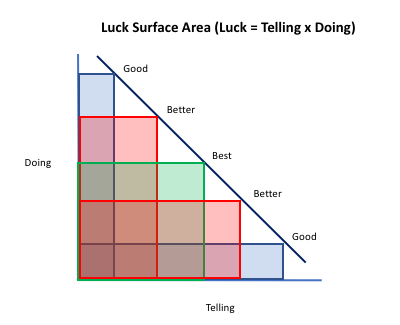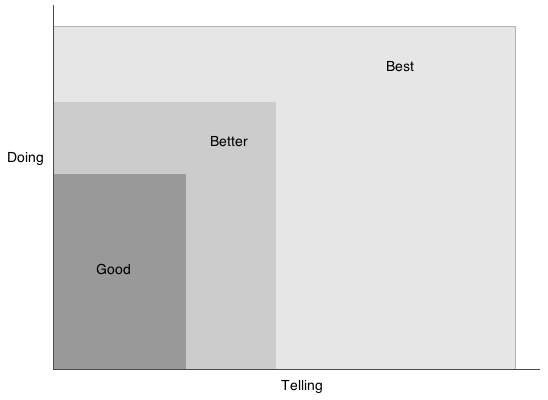Jason Roberts 2010 “Luck Surface Area” model explains the need for entrepreneurs to combine time spent doing and developing expertise with time spent communicating with others. It’s a very useful and actionable insight. Unfortunately, the diagram he chose to illustrate the model assumes that entrepreneurs have an unlimited amount of time to do both. I present a revised diagram that assumes total time is limited and that “doing/developing” and “communicating” compete for that time.
Jason Roberts’ Model for Luck Surface Area
You have a good idea, or you are trying to get something done. How do you increase your chance of success? One useful notion of how to improve your chances for a conversation, a suggestion, or an opportunity that moves you forward to success is to cultivate your “Luck Surface Area.” This is a term coined by Jason Roberts in a 2010 blog post “How to Increase Your Luck Surface Area”
The amount of serendipity that will occur in your life, your Luck Surface Area, is directly proportional to the degree to which you do something you’re passionate about combined with the total number of people to whom this is effectively communicated. It’s a simple concept, but an extremely powerful one because what it implies is that you can directly control the amount of luck you receive. In other words, you make your own luck.
Jason Roberts in “How to Increase Your Luck Surface Area” (2010)
Jason offers a very simple but very useful model: Luck = Telling x Doing.
Very simply if you increase the time “telling” and the time “doing” you will increase your luck surface area. The more “telling” and “doing” moves you through the good, better and best luck state. Intuitively this makes sense. If you are developing a product then the more telling and doing increases your chances of product success.
But Your Time is Limited
Jason’s model assumes you have as much time as you want for communicating and doing to increase luck. Realistically you have a limited amount of time and energy that you must divide time between communicating and doing. So, how does luck change based on how much time you spend on communicating verses doing?

More communicating comes at the expense of less doing and vice versa. You increase your luck surface area with a balance of doing and telling. At the extremes just telling and not doing and vice versa won’t get you very far.
Some Challenges in Balancing Telling and Doing
Figuring out the right or “getting close to” the right ratio for the task in hand is a complicated problem. Not many people consciously think about how much telling and doing is needed for a specific task. Here are a few factors consider:
- Relative Skill at Telling and Doing
If you enjoy doing but are less comfortable communicating with others you may need to spend more time on communicating (which involves is not only telling but listening). The reverse is also true. - Minimum block of time needed
What is the minimum amount of time needed in one setting or period to be minimally effective at communicating or doing. Development tasks typically have a setup time and benefit from few or no interruptions for concentrated mental effort. A morning spent recovering the context on a coding project is not a long enough focused effort to make progress. - Biological Rhythms
Consider the times of day and days of the week when you are most productive at doing. If they conflict with times that others are available for a conversation you will need to balance working at a lower productivity vs. a lack of progress on outreach and communication. - Death March / Unsustainable Effort
You can make more time available to telling and/or doing by cutting back on sleep, time spent with family and friends, exercise, and other activities that are important to your overall health and well-being. Most projects look more like marathons than sprints: avoid the temptation to work at an unsustainable pace unless it’s truly to sprint against a short deadline or to respond to a bona emergency. - Schedule Time and Look at Results as Much as Efforts.
It’s useful to schedule both your doing and your communicating tasks and to keep track both of time spent and results achieved. If others are excited about what you are creating but development progress has stalled it may be prudent to slack of on further communication efforts and focus on getting something ready to ship. Conversely if people are not really aware of what you have already developed but you want to make it “more better” before you start talking about it you may be falling into a “100% doing” trap. - Cluster Short Tasks for “Housekeeping” Time Blocks
Conversation and written communication can benefit as much from uninterrupted time as writing code or designing hardware. You may benefit clustering a set of short tasks into “housekeeping” blocks of time when an interruption only loses a small amount of time because you are restarting a small task. - Life Is Not School: Show Work in Progress Not Just Finished Work
It’s OK to compare notes with others. It’s more valuable to get early review feedback on a draft of an article or a sketch for an interface than to perfect it in isolation only to have early readers or early prospects point out flaws that would have been visible much earlier in the process.
Conclusion: Key Insight Behind Luck Surface Area is Very Sound
This post is intended to refine and extend Jason Roberts fundamental insight in “How to Increase Your Luck Surface Area” that you have to balance working on a product or project with communicating with folks about it. If all that you do is work on it and don’t solicit early feedback you risk going badly off track. If all you do is talk about it without making progress people will soon quit reading what you write and taking your calls. Vincent Van Gogh recognized a “doing” bias in his own life when he wrote the following:
“One may have a blazing hearth in one’s soul and yet no one ever comes to sit by it. Passersby see only a wisp of smoke from the chimney and continue on the way.”
Vincent van Gogh (1853-1890) in a letter to his brother Theo Dec-2-1882
A Chance to Practice in our Customer Discovery Bootcamp Starting Oct 18 2021
Next week we kick off a bootcamp for customer discovery that includes several exercises design to strengthen your outreach effectiveness. It’s on the inverted classroom model and has proven very popular. You can learn more and sign up at “Customer Discovery Bootcamp for Market Exploration”
Related Blog Posts
- Reflections on Serendipity video of key points in this post
- Knowledge Work Productivity
- The Benefits of Collaborative Writing, Interviewing, and Improvisation
- By Sunday Night Your Chips are Down for the Week
- Focus Needs Buffers and Free Time
- Entrepreneurial Mindset: Create Value for Others
- Naval Ravikant On Avoiding Bad Luck
- The Lucky and the Wise
- Early Sales Efforts Foster Value Co-Creation
This article is also published on LinkedIn and Medium
Update: I sent Jason Roberts a link to this blog and he discussed it with Justin Vincent on Techzing episode 321 http://techzinglive.com/page/1660/321-tz-discussion-quick-and-dirty (starts at 6:30 for about 3 minutes).
Update: (Dec-5-2022) A comment by Charles Lambdin:
I hear a lot about the importance of showing your work immediately and getting feedback, that we need to avoid trying to perfect things before we share them.
That is SOMETIMES good advice. At other times, however, showing your work too early is a good way to get it shot down.
This triggered this quick response on my part, but I think it’s worth digging into more I think there are a number of factors:
- Level of shared trust
- Degree of alignment on goals
- Knowledge of audience, problem, or domain
- Are they “Big picture” (good early for organization)
- “Or more Focus on details” (good later for polishing)
- Opponent – can check your presentation of their views
- Enemy – you are right to be careful about tipping your hand, but some disclosure is probably unavoidable
I borrow from two frameworks
- Peter Block’s Empowered Manager model which is level of trust and level of agreement on goals
- High Trust / High Agreement – Ally
- High Trust / Low Agreement – Opponent
- Low Trust / High Agreement – Bedfellow
- Low Trust / Low Agreement – Enemy
- Some Trust / Some Agreement – Fence Sitter (focus on establishing trust first)
- Howard Stevenson model from Do Lunch or Be lunch which is alignment on goals and agreement on how world works


Nice concept
Pingback: 2020: One thing I learned from today’s bootstrappers breakfast meeting - BootstrappersBreakfast
Pingback: How to Be Serendipitous & Make Your Own Luck | Process Street | Checklist, Workflow and SOP Software